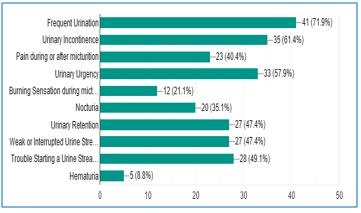Preferred methods of Diagnosis and Treatment of Benign Prostatic Hyperplasia adopted by Ayurveda practitioners - A Survey Study
DOI:
https://doi.org/10.21760/jaims.8.3.4Keywords:
Avagaha Swedana, Benign Prostatic Hyperplasia, Bladder Outlet Obstruction, Lower Urinary Tract Symptoms, Mutraaghata, Prostatomegaly, Uttara BastiAbstract
Introduction: Benign Prostatic Hyperplasia (BPH) refers to the nonmalignant growth of prostate gland. In Ayurveda, it can be correlated with Mutraaghata or Mutradosha. Currently used common oral medications such as 5α-reductase inhibitors, α1-Blockers as well as surgical treatment methods such as Transurethral Resection of the Prostate (TURP) have well-known side effects. Ayurveda case studies on BPH show evidence of a potential alternative to these current methods. Objectives: To conduct a survey to know the diagnostic methods and treatment modalities used by different Ayurveda Practitioners in BPH treatment. Materials & Methods: A survey comprising 7 questions in the form of multiple-choice questions on the diagnosis and treatment methods of BPH adopted by Ayurveda Physicians was done. The answers were recorded and interpreted in the form of graphs and pie charts. Results: A total of 57 different Ayurveda practitioners participated in the survey. Prevalence of BPH was seen more in the age group of 60-70 years. Ultrasonography (USG) and Prostate Specific Antigen (PSA) were among the most commonly used diagnostic methods for BPH. Most common symptoms observed were increased frequency of urine, urine incontinence and urine urgency. Uttara Basti (administration of medicine through the urethra) was the most recommended type of treatment procedure preferred, followed by Matra Basti (enema). Avagaha Swedana (Sitz bath) was recommended by most practitioners. The course duration of treatment is advised to be around half to one month. Around 40-60% relief was claimed in patients with BPH by the participants. Conclusion: BPH is a condition that is currently being treated by various Ayurveda practitioners using classical treatment methods such as Uttara Basti, Matra Basti etc. with claimed relief of about 40-60% by the participants.
Downloads
References
Roehrborn CG. Benign prostatic hyperplasia: an overview. Rev Urol. 2005;7 Suppl 9(Suppl 9):S3-S14.
Sushruta, Sushruta Samhita, Acharya Yadavji Trikamji (editor), Nibandha Sangraha Commentary by Dalhana, Nidana Sthana, Ashmarinidanam, 3/21-23, Varanasi: Chaukhamba Surabharati Prakashana; 2008, p280
Agnivesha, Charaka Samhita, Vidyotini Hindi commentary by Shastri K, Chaturvedi G. Part II, Siddhi Sthana, Trimarmiyarsiddhi, 9/25-26, Varanasi: Chaukhambha Bharti Academy; 2016, p.1057
Yu ZJ, Yan HL, Xu FH, Chao HC, Deng LH, Xu XD, Huang JB, Zeng T. Efficacy and Side Effects of Drugs Commonly Used for the Treatment of Lower Urinary Tract Symptoms Associated With Benign Prostatic Hyperplasia. Front Pharmacol. 2020 May 8;11:658. doi: 10.3389/fphar.2020.00658.
Lokeshwar SD, Harper BT, Webb E, Jordan A, Dykes TA, Neal DE Jr, Terris MK, Klaassen Z. Epidemiology and treatment modalities for the management of benign prostatic hyperplasia. Transl Androl Urol. 2019 Oct;8(5):529-539. doi: 10.21037/tau.2019.10.01.
Rassweiler J, Teber D, Kuntz R, Hofmann R. Complications of transurethral resection of the prostate (TURP)--incidence, management, and prevention. Eur Urol. 2006 Nov;50(5):969-79; discussion 980. doi: 10.1016/j.eururo.2005.12.042.
Roehrborn C, McConnell J. Etiology, pathophysiology, epidemiology and natural history of benign prostatic hyperplasia. In: Walsh P, Retik A, Vaughan E, Wein A, editors. Campbell’s Urology. 8th ed. Philadelphia: Saunders; 2002. pp. 1297–1336.
Sushruta, Sushruta Samhita, Acharya Yadavji Trikamji (editor), Nibandha Sangraha Commentary by Dalhana, Nidana Sthana, Ashmarinidanam, 3/27-28, Varanasi: Chaukhamba Surabharati Prakashana; 2008, p280
Agnivesha, Charaka Samhita, Vidyotini Hindi commentary by Shastri K, Chaturvedi G. Part II, Siddhi Sthana, Trimarmiyarsiddhi, 9/49-50, Varanasi: Chaukhambha Bharti Academy; 2016, p.1063.
G B, VD M, SK G, TS D. Efficacy of Ayurveda Formulations and Basti Chikitsa on Mutraghata w.s.r. to Benign Prostatic Hyperplasia: a review on researches conducted at Gujarat Ayurved University, Jamnagar. Int J Ayu Pharm Res. 2015Dec.15
Patel JK, Dudhamal TS, Gupta SK, Mahanta V. Efficacy of Kanchanara Guggulu and Matra Basti of Dhanyaka Gokshura Ghrita in Mootraghata (benign prostatic hyperplasia). Ayu. 2015 Apr-Jun;36(2):138-44. doi: 10.4103/0974-8520.175552.
Banothe GD, Mahanta V, Gupta SK, Dudhamal TS. A clinical evaluation of Kanchanara Guggulu and Bala Taila Matra Basti in the management of Mutraghata with special reference to benign prostatic hyperplasia. Ayu. 2018 Apr-Jun;39(2):65-71. doi: 10.4103/ayu.AYU_117_15.
Singh N, Shenoi UD, Raghuveer CV. FNAC and transabdominal ultrasonography in the diagnosis of prostatomegaly. Indian J Pathol Microbiol. 1997 Oct;40(4):473-9.
Benson MC, Whang IS, Olsson CA, McMahon DJ, Cooner WH. The use of prostate specific antigen density to enhance the predictive value of intermediate levels of serum prostate specific antigen. J Urol. 1992 Mar;147(3 Pt 2):817-21. doi: 10.1016/s0022-5347(17)37394-9.
Speakman MJ, Cheng X. Management of the complications of BPH/BOO. Indian J Urol. 2014 Apr;30(2):208-13. doi: 10.4103/0970-1591.127856.
Ashrani B, Sumedh W, Case study of ushiradya tail uttarbasti on vatasthila W.S.R to benign prostatic hyperplasia. Int J Res Ayurved Med Sci 2020;3:154-6.
Jaiswal AS, Yadav SR. Karkatibeejadi powder and Dhanyaka‑Gokshura Ghrita Matra Basti in the management of benign prostatic hyperplasia-case study. Int Ayurved Med J 2015;9:2942-7
Apaturkar NC, Khobragade SS, Karare P, Sawsakade P. Effect of laghupanchmooladi decoction hot sitz bath in the management of Mootraghata WSR to BPH: A case report. World J Pharm Res 2019;9:608-15
Kalogeromitros D, Makris M, Chliva C, Aggelides X, Kempuraj D, Theoharides TC. A quercetin containing supplement reduces niacin-induced flush in humans. Int J Immunopathol Pharmacol 2008;21:509-14.
Rohrmann S, Giovannucci E, Willett WC, Platz EA. Fruit and vegetable consumption, intake of micronutrients, and benign prostatic hyperplasia in US men. Am J Clin Nutr 2007;85:523-9















